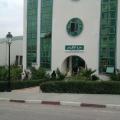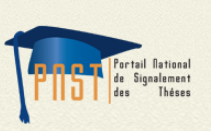System LMD
LMD system
Système LMD
General description of the LMD system
Training courses
License
The master
PhD
Architecture of the courses of formation in License
Courses of formation open at the University of Guelma
Teaching units (EU)
The credits
Sessions of control of knowledge and aptitudes
Regulatory texts
General description of the LMD system:
The LMD has long been in universities in Anglo-Saxon countries (United States, Canada, Great Britain, etc.). Its application has begun in recent years in Europe and also in some Arab countries and this with the aim of ensuring a better quality of higher education and to deliver graduate degrees of international value that will allow a certain mobility of students.
The LMD teaching system is conceived as an architecture in three cycles of training each conferring a university degree:
A first cycle: Bac +3 leading to the License.
A second cycle: Bac + 5 leading to the Master.
A third cycle: Bac + 8 leading to the PhD.
The training to obtain the "New Regime" License Diploma is organized by field of training grouping a set of sectors and specialties.
Training courses
License :
There are two types of licenses:
Academic License (L.A):
Dedicated to a Bachelor's degree that allows direct access to longer and more specialized university studies.
Professional License (L.P):
Devoted by a degree of license which will allow a direct insertion in the world of the work.
The master :
This training cycle takes place over two years. It is accessible to any student holding an Academic License (L.A) who fulfills the conditions of access. It does not exclude the holders of a Professional License (L.P) who will be able to return to the university after a passage in the professional life.
There are two types of Master:
Professional Master (M.P):
Characterized by the acquisition of greater specialization in a disciplinary field. The orientation of this course is still professional.
Research Master (M.R):
Characterized by a preparation for scientific research that is predestined for a research activity in the university and economic sectors.
PhD :
The doctoral training is of a minimum duration of three years and will have to ensure a deepening of the knowledge in the specialty and a training by and for the research (Development of the aptitudes with the research, sense of the work in team, ....).
Architecture of the courses of formation in License:
The training courses are structured in three levels
The first level:
Two semesters at most is a stage of impregnation and adaptation to university life and university discovery.
The second level:
At least two semesters is a stage of deepening knowledge and progressive orientation.
The third level:
Is a stage of specialization to acquire knowledge and skills in the chosen specialty.
Courses of formation open at the University of Guelma:
Training areas grouping a set of courses and specialties in the form of training courses.
Teaching units (EU):
Training courses are organized in teaching units (UE) and consist of one or more subjects taught in the form of courses (courses, tutorials or practices, seminars, internships, ...). The teaching units are distinguished into four categories.
Basic Education Unit:
It groups together the basic subjects of education necessary for the continuation of the studies of the concerned sector.
Discovery Teaching Unit:
It includes teaching subjects that broaden the student's knowledge horizon and open up other perspectives in the event of a reorientation.
Common educational unit (transversal):
It includes teaching subjects such as modern languages, computer science, information and communication technologies, humanities ...).
Specialty teaching unit:
It groups together the subjects of instruction concerning the chosen specialty.
Capitalization and transfer of U.E:
The unit of education thus acquired is capitalizable within the same training course and transferable to another training course including the said unit. The unit of education thus acquired is capitalizable within the same training course and transferable to another training course including the said unit. This capitalization and transfer of the teaching unit allows the establishment of bridges between the various training courses and creates a mobility of students for the pursuit of their studies in other training courses of their own choice.
The credits :
Credit is a unit of measure of lessons learned. Each teaching unit and each subject has a determined value in terms of credits The value in credits is determined by reference to the "academic" semester volume and to the volume of the student's activities The credit value of an EU is determined in relation to the total value set at 30 credits per semester.
Evaluation and Progression:
The value of all degrees is defined by the common reference credit.
License: 180 credits.
Master's degree: 120 credits.
PhD: Minimum 3 years.
Sessions of control of knowledge and aptitudes:
Two knowledge control sessions are organized for each teaching semester. An ordinary session at the end of the semester A second session is the one of the retrofit organized in September for each of the two semesters of the same academic year.
The acquisition of the semester:
The semester can be acquired in two ways.
- For any student who has obtained all EU.
- By compensation between the different UEs composing the semester weighted by their respective coefficients. The semester is then acquired if the general average is greater than or equal to 10/20.
Failure at first session (ordinary):
- The student shows up at the second session in unvested units.
- The student keeps the benefit of EU subjects where he obtained an average of> = 10/20.
- The student must sit for the examinations of unearned subjects.
The EU is acquired at the end of the second session if the average is> = 10/20
The average for each subject is calculated on the basis of the mark obtained during the examination of this second session and the non-modifiable notes of the continuous assessment of the knowledge obtained during the semester
The progression from the first to the second semester:
Progression from the first to the second semester of the same academic year is right for any student enrolled in the same course.
Progression from the first to the second year:
- The two semesters of the same training course.
- At least 30 credits and this after deliberation of the training team.
Progression from second to third year:
The progression from the second to the third year of the "new scheme" license for any student having acquired.
- The four semesters of the same training course.
- 80% of the credits relating to the four semesters and having validated the fundamental EU and after deliberation of the training team.
Students who are not admitted to the second or third year of a training course may be allowed to re-enroll in the same course or to another course.
Regulatory texts :
- Décret exécutif n° 08-265 du 17 Chaâbane 1429 correspondant au 19 août 2008 portant régime des études en vue de l'obtention du diplôme de licence, du diplôme de master et du diplôme de doctorat.
- Arreté n° 711 du 03 novembre 2011 fixant les règles d'organisation et de gestion pédagogiques communes aux études universitaires en vue de l'obtention des diplomes de licence et de master
- Arreté n° 712 du 03 novembre 2011 fixant les modalités d'évaluation, de progression et d'orientation dans les cycles d'études en vue de l'obtention des diplomes de licence et de master
- Arreté n° 713 du 03 novembre 2011 fixant la composition et le fonctionnement de la commission du tutorat
- Arreté n° 714 du 03 novembre 2011 portant modalités de classement des étudiants
- Arreté n° 715 du 03 novembre 2011 fixant les conditions d'obtention du diplome de master aux étudiants inscrits pour l'obtention du du diplome d'ingenieur d'Etat, du diplome d'architecte dans les écoles hors université
- Arreté n° 451 du 09 Décembre 2012 portant définition des caractéristiques relatives à l'attestation provisoire de succés dans les cycles d'études en vue de l'obtention du diplome de licence et du diplome de master
- Arreté n° 452 du 09 Décembre 2012 portant définition des caractéristiques relatives au relevé de notes dans les cycles d'études en vue de l'obtention du diplome de licence et du diplome de master
- Arreté n° 453 du 09 Décembre 2012 portant définition des caractéristiques relatives au document descriptif annexé au diplome de licence et au diplome de master














